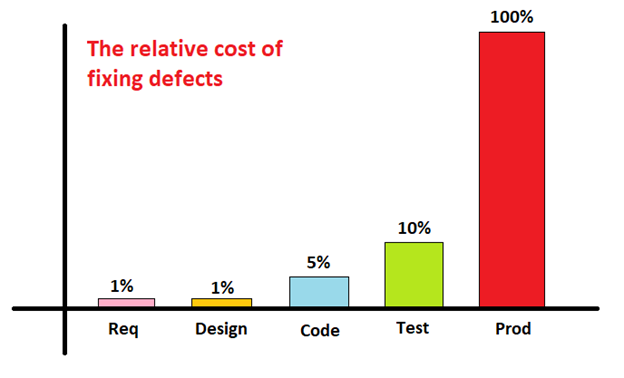Software testing is a method to validate that the produced software is working as expected as given in the requirements and to make sure that the product is free from bugs. it is nothing but running the application/system under both normal and abnormal conditions and comparing the result against Requirement/functionality. At the same time, we should take corrective action on the result which we do not expect.
Cyclone testing is a type of testing that is usually done to reduce the bug fixing cost and human efforts. We contrast “Cyclone Testing in Software Development” with “Cyclone Testing in Meteorology” to better understand the former.
In meteorology “Cyclone” is the huge air mass that rotates towards the center of the low atmospheric pressure. Because cyclones can have extremely damaging effects, below are some points that indicate why cyclone testing is necessary:
- To measure the capacity of the product.
- To measure the Capability and to improve the performance of the product.
- To ensure efficient use of materials.
- To save time and money after impact.
- To ensure the rigidity of the product under severe conditions.
- To minimize loss and to implement preventative actions.
Cyclone Testing in Software Technology
A cyclone in meteorology can be destructive and needs to be evaluated, just as we understand its destructive potential.
similarly, In Software engineering, we carry out Cyclone Testing to verify the features, capacity, efficiency, and capabilities of the product. This testing prevents the wasting of time and money.
When and How to do Cyclone Testing
- When the developer has completed the code but has not yet deployed it in the testing environment (the codes are in the developer’s local directory), cyclone testing comes into the picture.
- Typically, the developer shares the Tester on his screen and explains the user story, including each step’s expected outcome.
- The tester begins to clarify his doubts and ask questions. He can even request control and perform some testing to identify the problem.
- To fully understand the requirements and functionality for the next testing phase, the entire screen-sharing session might be recorded.
We can understand the procedure with a text field validation.
“For instance, suppose it is required that an email field text box should have “@” in the email id for an email text field. To test this, the tester can request that the “@” symbol be removed from the email address. Quality Analysts can request control and carry out certain fundamental functional tests independently. If it does not work, the developer can quickly resolve the problem and needs less effort.”

fig: Cyclone Testing Session
However, identifying bugs throughout the cyclone testing process is crucial since it can reduce loss by identifying problems early on. “The relative cost of fixing defects” can be understood by studying relative COST vs. SDLC (Software Development Life Cycle). The relative cost is rising as the SDLC stages progress, as seen in the chart below. The cost will be half of the testing phase if the bug is discovered during the coding phase.

fig: Relative Cost vs. SDLC Phases
Advantages of the Cyclone Testing
- It helps to reduce the cost and enhance the quality.
- We can quickly detect and fix the bugs, which is the fact that cyclone testing is a cost saver.
- It saves time and reduces the extra overhead of tracking the bug if found in the test environment.
- A product will be more difficult to fix if it has more bugs. Since bugs tend to multiply, many more will soon appear.
- It helps QA to understand the requirements and functionality.
- It reduces team’s efforts of rework.
Frequently Asked Questions
-
What should be the mindset of a tester during cyclone testing?
-
- He should think from the end customer’s point of view.
- His attitude towards testing should be thoroughly destructive, but his approach to testing should be constructive then, and he will be able to find more bugs.
- He should be a go-getter and could prove his opinion despite all odds.
- Having a lot of patience.
-
At what stage of the SDLC does cyclone testing begin?
-
- Project initiations
- Requirement Analysis & Gathering
- System Design
- System Development
- Cyclone Testing
-
What would the roadmap or process look like for a ticket lifecycle? Would there be any changes to the workflows?
-
- There is no need to modify the ticket lifecycle. After the developer completes the User Story (the code is on his local drive), he tells the QA Team, explains the feature, and provides a demo. A QA Engineer then conducts ad hoc testing on the developer’s computer, and if the tester finds any bug, the developer promptly resolves it without creating any bug ticket.
-
You mentioned screen share and potentially recording testing sessions with the developer; how do you cover or track it in the ticket?
-
- If the cyclone testing passes, the developer will attach the recording to the ticket with his comment, “Cyclone testing- Done,” and the recording of the session.
-
Cyclone testing refers only to the initial testing for a story or enhancement ticket; where would integration and regression testing fit in?
-
- As it relates to new features to help testers and developers better understand the requirements and fix difficulties in the initial stages, it is irrelevant for integration and regression testing.
Implementation of cyclone testing in your project gives you a unique way of Software testing. It all comes down to saving money, time, and human effort. An overview of the benefits and significance of Cyclone testing is provided in this article. I hope you found this post interesting to read and helpful.

